NSC2500: Hodgkin Lymphoma and Chemotherapy - A Nursing Guide
VerifiedAdded on 2022/09/09
|15
|3279
|26
Report
AI Summary
This report examines Hodgkin lymphoma, a cancer affecting the lymphatic system, and its treatment with the chemotherapy drug doxorubicin. It begins with an introduction to the circulatory system and the role of the heart. The summary covers the disease's pathophysiology, including the clonal transformation of B cells and the generation of Reed-Sternberg cells. It then details the pharmacology of doxorubicin, including its mechanism of action, pharmacokinetics, and route of administration. The report also addresses indications, contraindications, precautions, side effects, and lifestyle changes for patients. The target audience is nursing professionals, emphasizing their role in patient care, medication administration, and improving patient outcomes. The conclusion highlights the importance of proper drug administration by nurses to enhance patient survival rates and overall quality of life. References from various scientific articles support the information provided in this report.
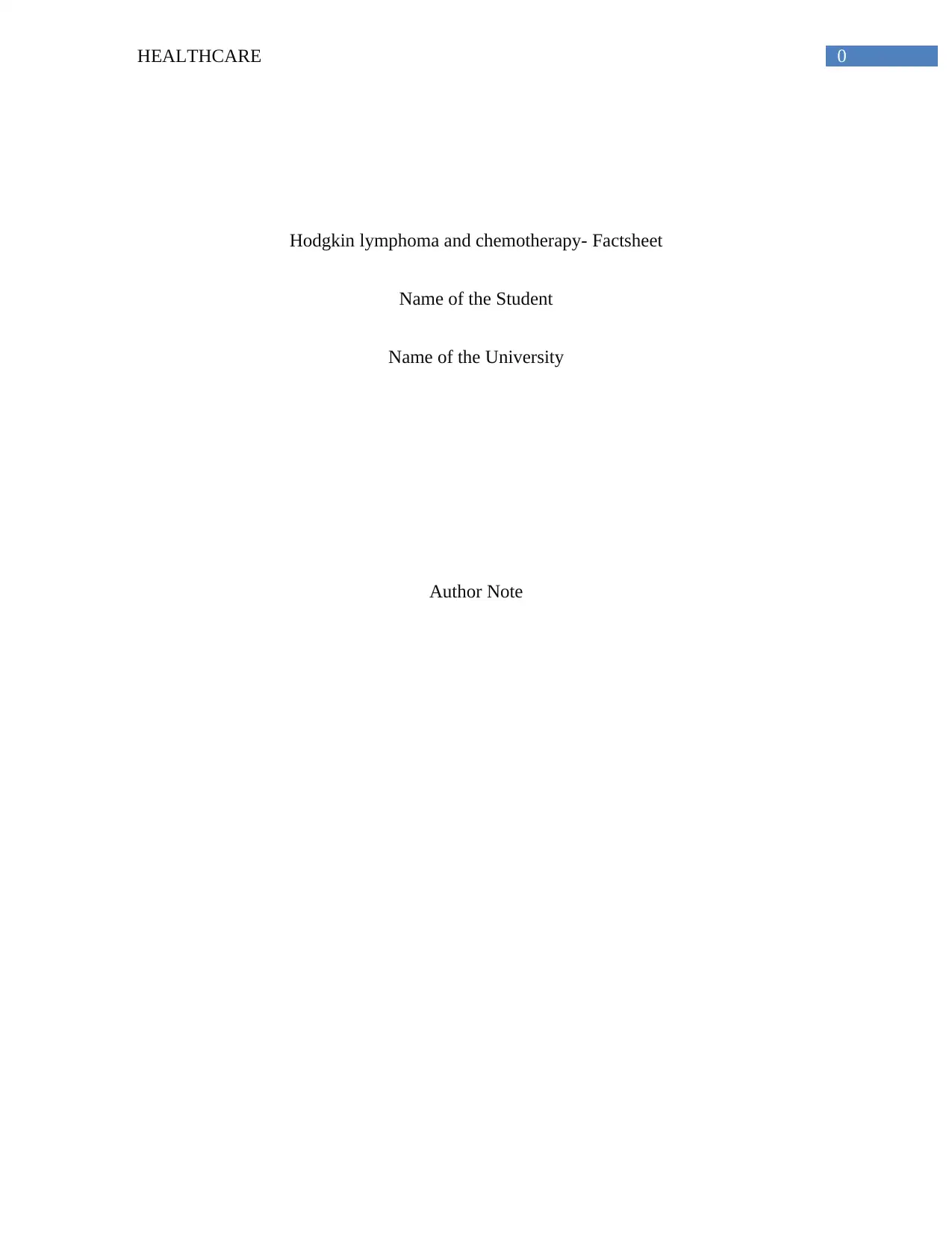
0HEALTHCARE
Hodgkin lymphoma and chemotherapy- Factsheet
Name of the Student
Name of the University
Author Note
Hodgkin lymphoma and chemotherapy- Factsheet
Name of the Student
Name of the University
Author Note
Paraphrase This Document
Need a fresh take? Get an instant paraphrase of this document with our AI Paraphraser
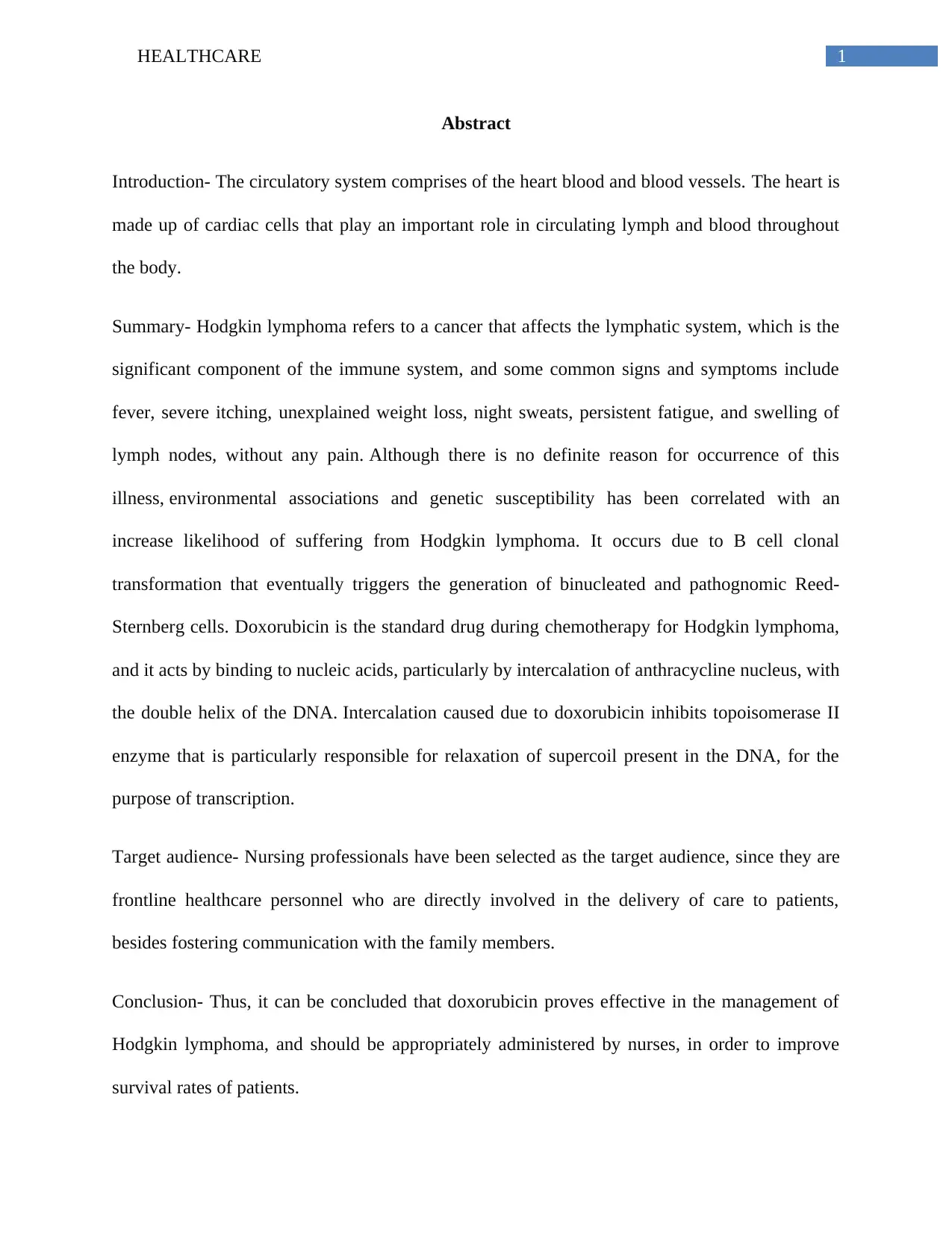
1HEALTHCARE
Abstract
Introduction- The circulatory system comprises of the heart blood and blood vessels. The heart is
made up of cardiac cells that play an important role in circulating lymph and blood throughout
the body.
Summary- Hodgkin lymphoma refers to a cancer that affects the lymphatic system, which is the
significant component of the immune system, and some common signs and symptoms include
fever, severe itching, unexplained weight loss, night sweats, persistent fatigue, and swelling of
lymph nodes, without any pain. Although there is no definite reason for occurrence of this
illness, environmental associations and genetic susceptibility has been correlated with an
increase likelihood of suffering from Hodgkin lymphoma. It occurs due to B cell clonal
transformation that eventually triggers the generation of binucleated and pathognomic Reed-
Sternberg cells. Doxorubicin is the standard drug during chemotherapy for Hodgkin lymphoma,
and it acts by binding to nucleic acids, particularly by intercalation of anthracycline nucleus, with
the double helix of the DNA. Intercalation caused due to doxorubicin inhibits topoisomerase II
enzyme that is particularly responsible for relaxation of supercoil present in the DNA, for the
purpose of transcription.
Target audience- Nursing professionals have been selected as the target audience, since they are
frontline healthcare personnel who are directly involved in the delivery of care to patients,
besides fostering communication with the family members.
Conclusion- Thus, it can be concluded that doxorubicin proves effective in the management of
Hodgkin lymphoma, and should be appropriately administered by nurses, in order to improve
survival rates of patients.
Abstract
Introduction- The circulatory system comprises of the heart blood and blood vessels. The heart is
made up of cardiac cells that play an important role in circulating lymph and blood throughout
the body.
Summary- Hodgkin lymphoma refers to a cancer that affects the lymphatic system, which is the
significant component of the immune system, and some common signs and symptoms include
fever, severe itching, unexplained weight loss, night sweats, persistent fatigue, and swelling of
lymph nodes, without any pain. Although there is no definite reason for occurrence of this
illness, environmental associations and genetic susceptibility has been correlated with an
increase likelihood of suffering from Hodgkin lymphoma. It occurs due to B cell clonal
transformation that eventually triggers the generation of binucleated and pathognomic Reed-
Sternberg cells. Doxorubicin is the standard drug during chemotherapy for Hodgkin lymphoma,
and it acts by binding to nucleic acids, particularly by intercalation of anthracycline nucleus, with
the double helix of the DNA. Intercalation caused due to doxorubicin inhibits topoisomerase II
enzyme that is particularly responsible for relaxation of supercoil present in the DNA, for the
purpose of transcription.
Target audience- Nursing professionals have been selected as the target audience, since they are
frontline healthcare personnel who are directly involved in the delivery of care to patients,
besides fostering communication with the family members.
Conclusion- Thus, it can be concluded that doxorubicin proves effective in the management of
Hodgkin lymphoma, and should be appropriately administered by nurses, in order to improve
survival rates of patients.

2HEALTHCARE
Keywords: Hodgkin lymphoma, chemotherapy, doxorubicin
Keywords: Hodgkin lymphoma, chemotherapy, doxorubicin
⊘ This is a preview!⊘
Do you want full access?
Subscribe today to unlock all pages.

Trusted by 1+ million students worldwide
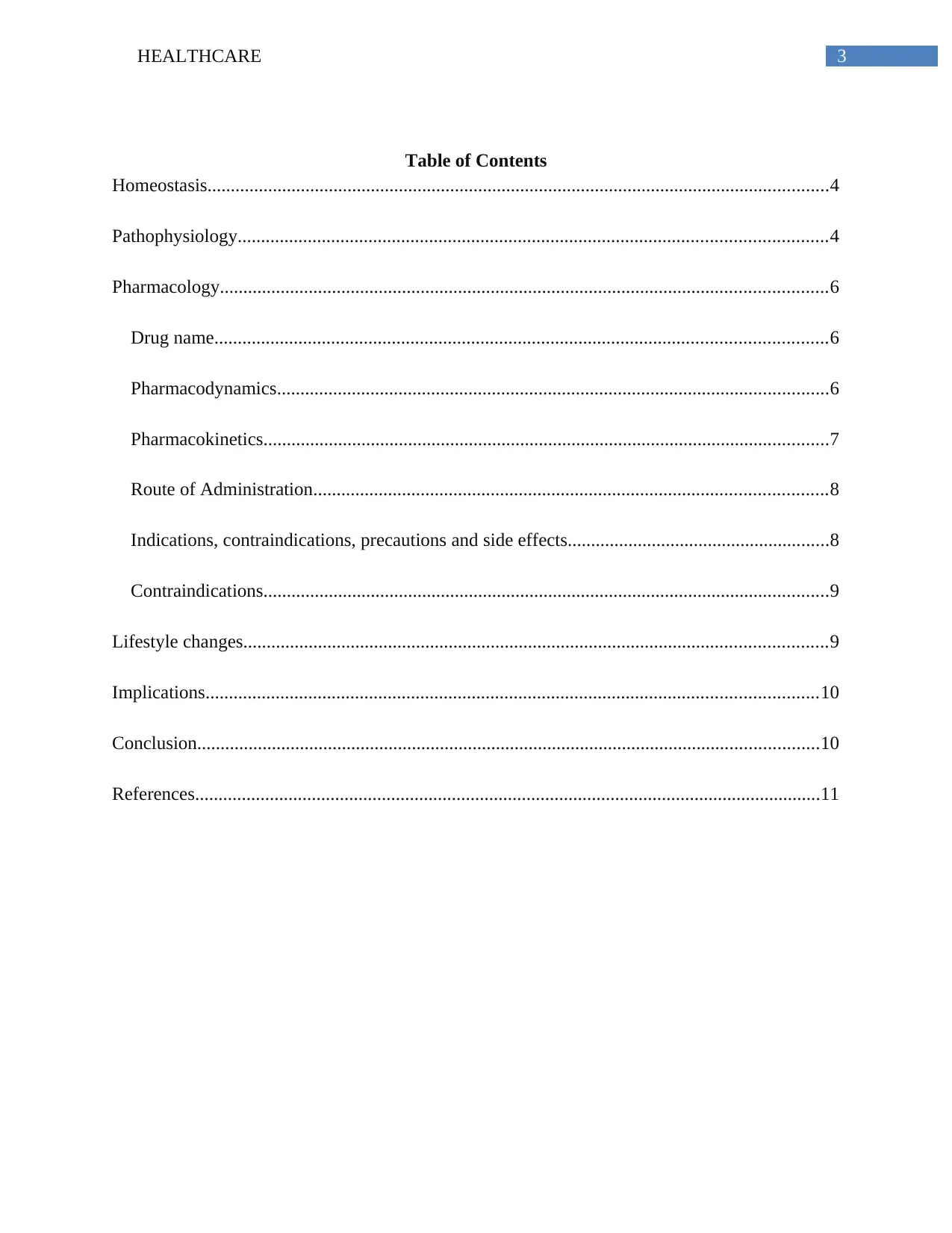
3HEALTHCARE
Table of Contents
Homeostasis.....................................................................................................................................4
Pathophysiology..............................................................................................................................4
Pharmacology..................................................................................................................................6
Drug name...................................................................................................................................6
Pharmacodynamics......................................................................................................................6
Pharmacokinetics.........................................................................................................................7
Route of Administration..............................................................................................................8
Indications, contraindications, precautions and side effects........................................................8
Contraindications.........................................................................................................................9
Lifestyle changes.............................................................................................................................9
Implications...................................................................................................................................10
Conclusion.....................................................................................................................................10
References......................................................................................................................................11
Table of Contents
Homeostasis.....................................................................................................................................4
Pathophysiology..............................................................................................................................4
Pharmacology..................................................................................................................................6
Drug name...................................................................................................................................6
Pharmacodynamics......................................................................................................................6
Pharmacokinetics.........................................................................................................................7
Route of Administration..............................................................................................................8
Indications, contraindications, precautions and side effects........................................................8
Contraindications.........................................................................................................................9
Lifestyle changes.............................................................................................................................9
Implications...................................................................................................................................10
Conclusion.....................................................................................................................................10
References......................................................................................................................................11
Paraphrase This Document
Need a fresh take? Get an instant paraphrase of this document with our AI Paraphraser
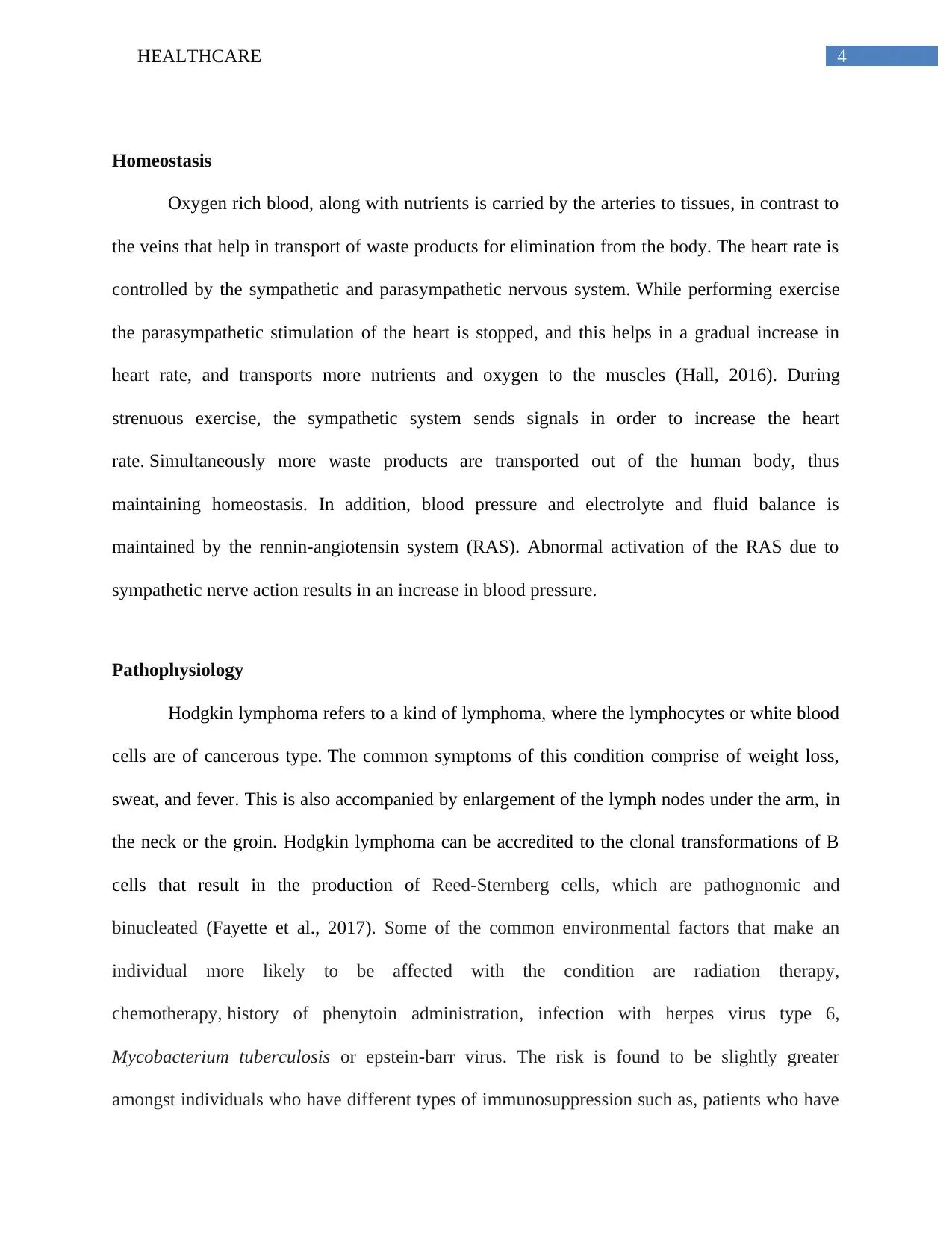
4HEALTHCARE
Homeostasis
Oxygen rich blood, along with nutrients is carried by the arteries to tissues, in contrast to
the veins that help in transport of waste products for elimination from the body. The heart rate is
controlled by the sympathetic and parasympathetic nervous system. While performing exercise
the parasympathetic stimulation of the heart is stopped, and this helps in a gradual increase in
heart rate, and transports more nutrients and oxygen to the muscles (Hall, 2016). During
strenuous exercise, the sympathetic system sends signals in order to increase the heart
rate. Simultaneously more waste products are transported out of the human body, thus
maintaining homeostasis. In addition, blood pressure and electrolyte and fluid balance is
maintained by the rennin-angiotensin system (RAS). Abnormal activation of the RAS due to
sympathetic nerve action results in an increase in blood pressure.
Pathophysiology
Hodgkin lymphoma refers to a kind of lymphoma, where the lymphocytes or white blood
cells are of cancerous type. The common symptoms of this condition comprise of weight loss,
sweat, and fever. This is also accompanied by enlargement of the lymph nodes under the arm, in
the neck or the groin. Hodgkin lymphoma can be accredited to the clonal transformations of B
cells that result in the production of Reed-Sternberg cells, which are pathognomic and
binucleated (Fayette et al., 2017). Some of the common environmental factors that make an
individual more likely to be affected with the condition are radiation therapy,
chemotherapy, history of phenytoin administration, infection with herpes virus type 6,
Mycobacterium tuberculosis or epstein-barr virus. The risk is found to be slightly greater
amongst individuals who have different types of immunosuppression such as, patients who have
Homeostasis
Oxygen rich blood, along with nutrients is carried by the arteries to tissues, in contrast to
the veins that help in transport of waste products for elimination from the body. The heart rate is
controlled by the sympathetic and parasympathetic nervous system. While performing exercise
the parasympathetic stimulation of the heart is stopped, and this helps in a gradual increase in
heart rate, and transports more nutrients and oxygen to the muscles (Hall, 2016). During
strenuous exercise, the sympathetic system sends signals in order to increase the heart
rate. Simultaneously more waste products are transported out of the human body, thus
maintaining homeostasis. In addition, blood pressure and electrolyte and fluid balance is
maintained by the rennin-angiotensin system (RAS). Abnormal activation of the RAS due to
sympathetic nerve action results in an increase in blood pressure.
Pathophysiology
Hodgkin lymphoma refers to a kind of lymphoma, where the lymphocytes or white blood
cells are of cancerous type. The common symptoms of this condition comprise of weight loss,
sweat, and fever. This is also accompanied by enlargement of the lymph nodes under the arm, in
the neck or the groin. Hodgkin lymphoma can be accredited to the clonal transformations of B
cells that result in the production of Reed-Sternberg cells, which are pathognomic and
binucleated (Fayette et al., 2017). Some of the common environmental factors that make an
individual more likely to be affected with the condition are radiation therapy,
chemotherapy, history of phenytoin administration, infection with herpes virus type 6,
Mycobacterium tuberculosis or epstein-barr virus. The risk is found to be slightly greater
amongst individuals who have different types of immunosuppression such as, patients who have
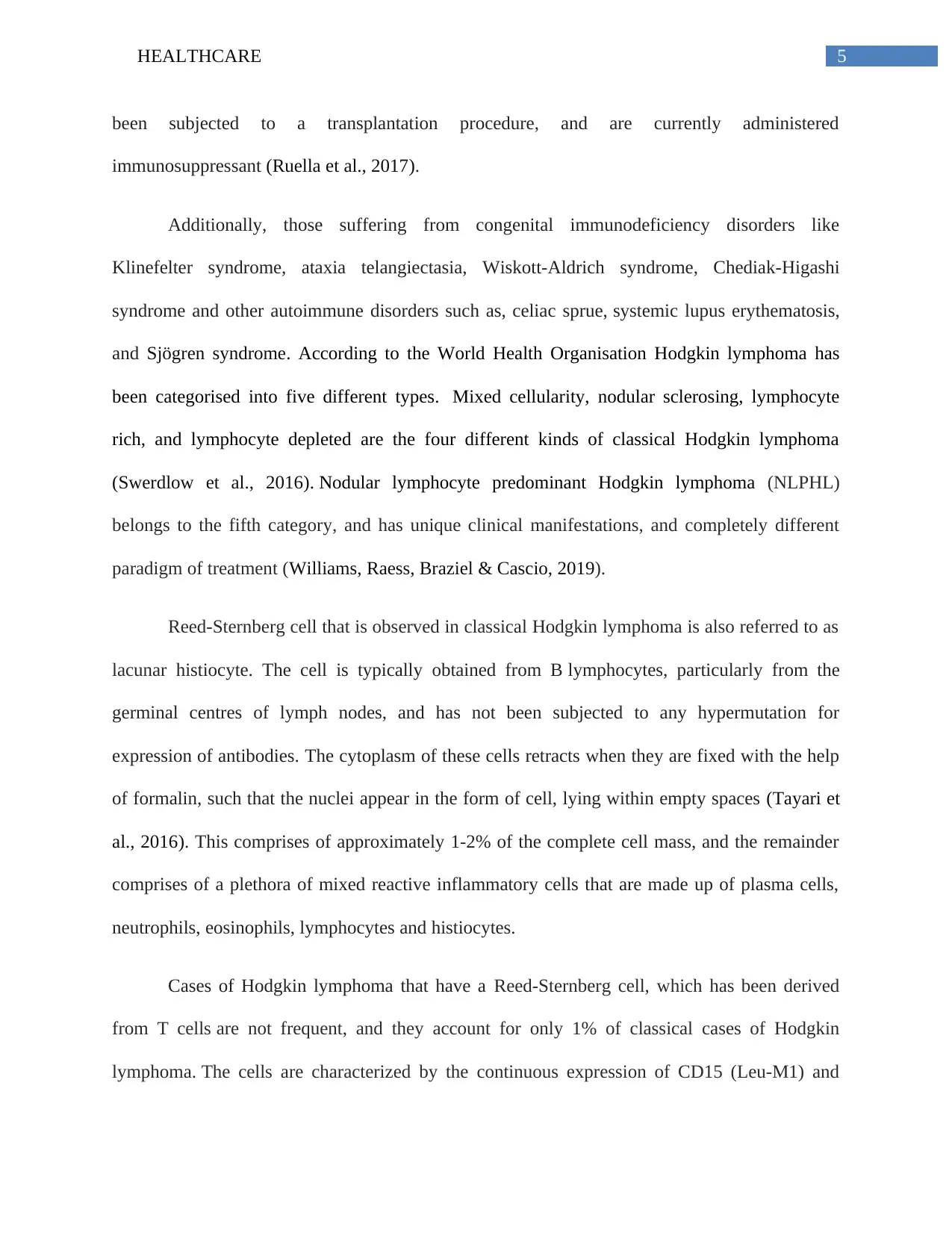
5HEALTHCARE
been subjected to a transplantation procedure, and are currently administered
immunosuppressant (Ruella et al., 2017).
Additionally, those suffering from congenital immunodeficiency disorders like
Klinefelter syndrome, ataxia telangiectasia, Wiskott-Aldrich syndrome, Chediak-Higashi
syndrome and other autoimmune disorders such as, celiac sprue, systemic lupus erythematosis,
and Sjögren syndrome. According to the World Health Organisation Hodgkin lymphoma has
been categorised into five different types. Mixed cellularity, nodular sclerosing, lymphocyte
rich, and lymphocyte depleted are the four different kinds of classical Hodgkin lymphoma
(Swerdlow et al., 2016). Nodular lymphocyte predominant Hodgkin lymphoma (NLPHL)
belongs to the fifth category, and has unique clinical manifestations, and completely different
paradigm of treatment (Williams, Raess, Braziel & Cascio, 2019).
Reed-Sternberg cell that is observed in classical Hodgkin lymphoma is also referred to as
lacunar histiocyte. The cell is typically obtained from B lymphocytes, particularly from the
germinal centres of lymph nodes, and has not been subjected to any hypermutation for
expression of antibodies. The cytoplasm of these cells retracts when they are fixed with the help
of formalin, such that the nuclei appear in the form of cell, lying within empty spaces (Tayari et
al., 2016). This comprises of approximately 1-2% of the complete cell mass, and the remainder
comprises of a plethora of mixed reactive inflammatory cells that are made up of plasma cells,
neutrophils, eosinophils, lymphocytes and histiocytes.
Cases of Hodgkin lymphoma that have a Reed-Sternberg cell, which has been derived
from T cells are not frequent, and they account for only 1% of classical cases of Hodgkin
lymphoma. The cells are characterized by the continuous expression of CD15 (Leu-M1) and
been subjected to a transplantation procedure, and are currently administered
immunosuppressant (Ruella et al., 2017).
Additionally, those suffering from congenital immunodeficiency disorders like
Klinefelter syndrome, ataxia telangiectasia, Wiskott-Aldrich syndrome, Chediak-Higashi
syndrome and other autoimmune disorders such as, celiac sprue, systemic lupus erythematosis,
and Sjögren syndrome. According to the World Health Organisation Hodgkin lymphoma has
been categorised into five different types. Mixed cellularity, nodular sclerosing, lymphocyte
rich, and lymphocyte depleted are the four different kinds of classical Hodgkin lymphoma
(Swerdlow et al., 2016). Nodular lymphocyte predominant Hodgkin lymphoma (NLPHL)
belongs to the fifth category, and has unique clinical manifestations, and completely different
paradigm of treatment (Williams, Raess, Braziel & Cascio, 2019).
Reed-Sternberg cell that is observed in classical Hodgkin lymphoma is also referred to as
lacunar histiocyte. The cell is typically obtained from B lymphocytes, particularly from the
germinal centres of lymph nodes, and has not been subjected to any hypermutation for
expression of antibodies. The cytoplasm of these cells retracts when they are fixed with the help
of formalin, such that the nuclei appear in the form of cell, lying within empty spaces (Tayari et
al., 2016). This comprises of approximately 1-2% of the complete cell mass, and the remainder
comprises of a plethora of mixed reactive inflammatory cells that are made up of plasma cells,
neutrophils, eosinophils, lymphocytes and histiocytes.
Cases of Hodgkin lymphoma that have a Reed-Sternberg cell, which has been derived
from T cells are not frequent, and they account for only 1% of classical cases of Hodgkin
lymphoma. The cells are characterized by the continuous expression of CD15 (Leu-M1) and
⊘ This is a preview!⊘
Do you want full access?
Subscribe today to unlock all pages.

Trusted by 1+ million students worldwide
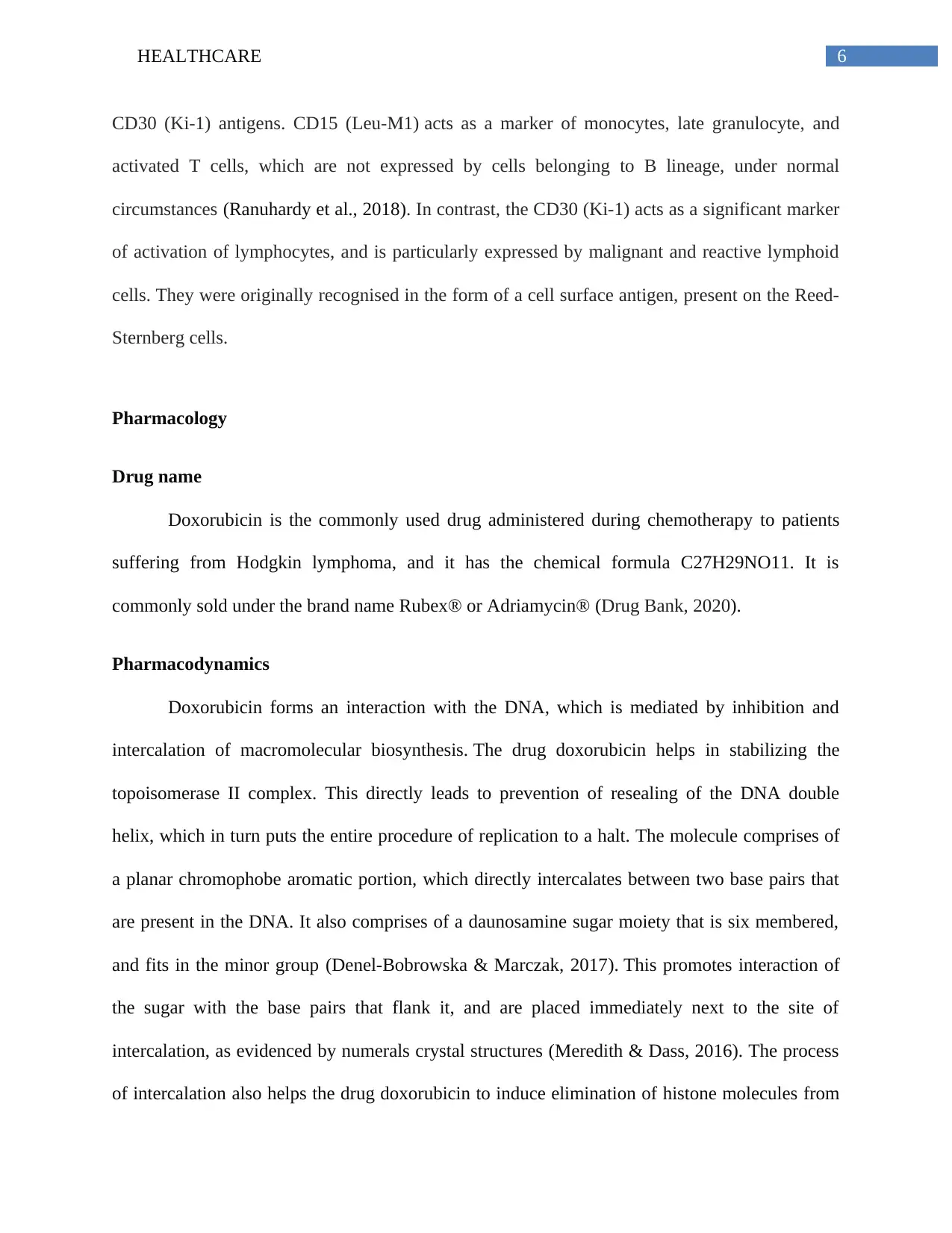
6HEALTHCARE
CD30 (Ki-1) antigens. CD15 (Leu-M1) acts as a marker of monocytes, late granulocyte, and
activated T cells, which are not expressed by cells belonging to B lineage, under normal
circumstances (Ranuhardy et al., 2018). In contrast, the CD30 (Ki-1) acts as a significant marker
of activation of lymphocytes, and is particularly expressed by malignant and reactive lymphoid
cells. They were originally recognised in the form of a cell surface antigen, present on the Reed-
Sternberg cells.
Pharmacology
Drug name
Doxorubicin is the commonly used drug administered during chemotherapy to patients
suffering from Hodgkin lymphoma, and it has the chemical formula C27H29NO11. It is
commonly sold under the brand name Rubex® or Adriamycin® (Drug Bank, 2020).
Pharmacodynamics
Doxorubicin forms an interaction with the DNA, which is mediated by inhibition and
intercalation of macromolecular biosynthesis. The drug doxorubicin helps in stabilizing the
topoisomerase II complex. This directly leads to prevention of resealing of the DNA double
helix, which in turn puts the entire procedure of replication to a halt. The molecule comprises of
a planar chromophobe aromatic portion, which directly intercalates between two base pairs that
are present in the DNA. It also comprises of a daunosamine sugar moiety that is six membered,
and fits in the minor group (Denel-Bobrowska & Marczak, 2017). This promotes interaction of
the sugar with the base pairs that flank it, and are placed immediately next to the site of
intercalation, as evidenced by numerals crystal structures (Meredith & Dass, 2016). The process
of intercalation also helps the drug doxorubicin to induce elimination of histone molecules from
CD30 (Ki-1) antigens. CD15 (Leu-M1) acts as a marker of monocytes, late granulocyte, and
activated T cells, which are not expressed by cells belonging to B lineage, under normal
circumstances (Ranuhardy et al., 2018). In contrast, the CD30 (Ki-1) acts as a significant marker
of activation of lymphocytes, and is particularly expressed by malignant and reactive lymphoid
cells. They were originally recognised in the form of a cell surface antigen, present on the Reed-
Sternberg cells.
Pharmacology
Drug name
Doxorubicin is the commonly used drug administered during chemotherapy to patients
suffering from Hodgkin lymphoma, and it has the chemical formula C27H29NO11. It is
commonly sold under the brand name Rubex® or Adriamycin® (Drug Bank, 2020).
Pharmacodynamics
Doxorubicin forms an interaction with the DNA, which is mediated by inhibition and
intercalation of macromolecular biosynthesis. The drug doxorubicin helps in stabilizing the
topoisomerase II complex. This directly leads to prevention of resealing of the DNA double
helix, which in turn puts the entire procedure of replication to a halt. The molecule comprises of
a planar chromophobe aromatic portion, which directly intercalates between two base pairs that
are present in the DNA. It also comprises of a daunosamine sugar moiety that is six membered,
and fits in the minor group (Denel-Bobrowska & Marczak, 2017). This promotes interaction of
the sugar with the base pairs that flank it, and are placed immediately next to the site of
intercalation, as evidenced by numerals crystal structures (Meredith & Dass, 2016). The process
of intercalation also helps the drug doxorubicin to induce elimination of histone molecules from
Paraphrase This Document
Need a fresh take? Get an instant paraphrase of this document with our AI Paraphraser
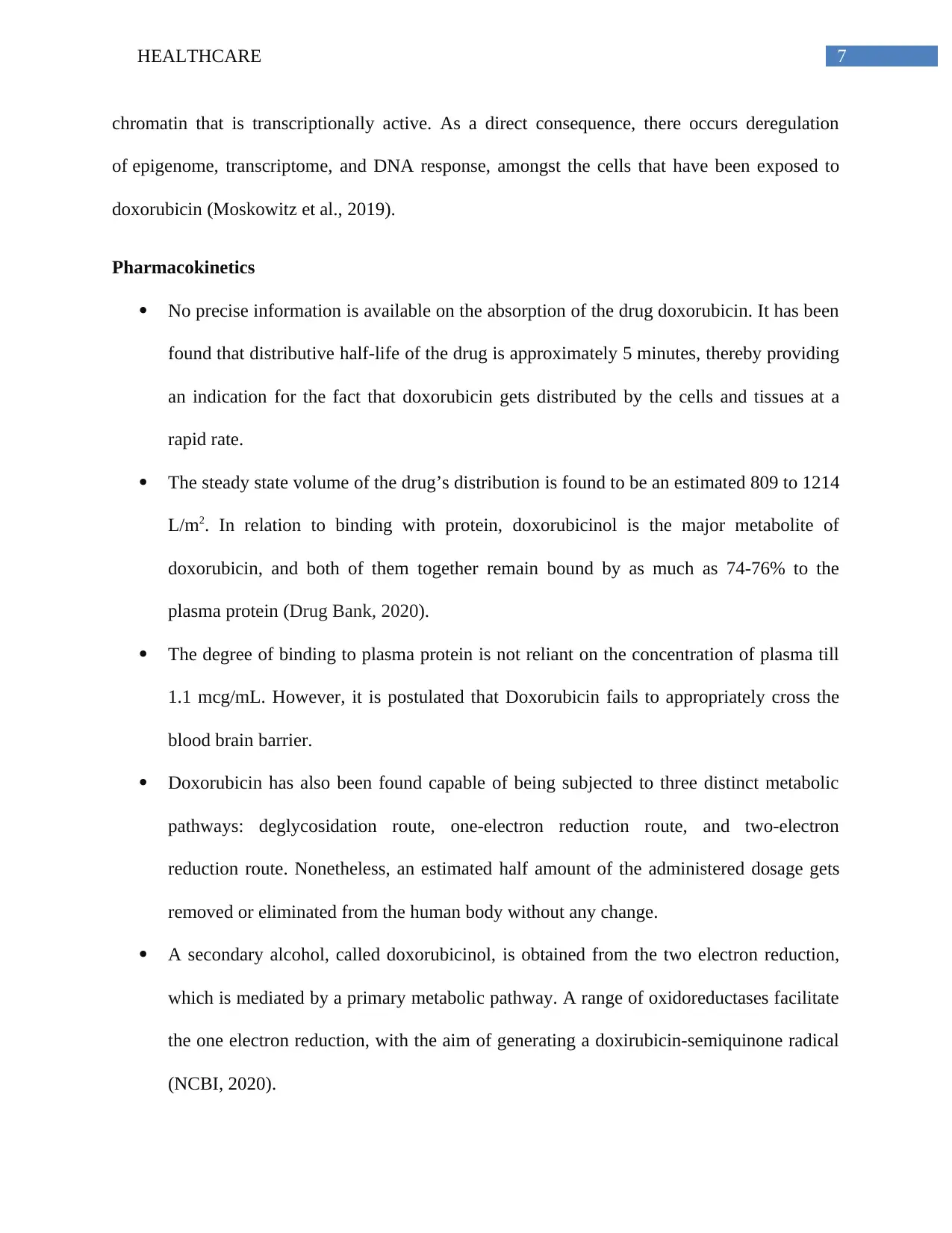
7HEALTHCARE
chromatin that is transcriptionally active. As a direct consequence, there occurs deregulation
of epigenome, transcriptome, and DNA response, amongst the cells that have been exposed to
doxorubicin (Moskowitz et al., 2019).
Pharmacokinetics
No precise information is available on the absorption of the drug doxorubicin. It has been
found that distributive half-life of the drug is approximately 5 minutes, thereby providing
an indication for the fact that doxorubicin gets distributed by the cells and tissues at a
rapid rate.
The steady state volume of the drug’s distribution is found to be an estimated 809 to 1214
L/m2. In relation to binding with protein, doxorubicinol is the major metabolite of
doxorubicin, and both of them together remain bound by as much as 74-76% to the
plasma protein (Drug Bank, 2020).
The degree of binding to plasma protein is not reliant on the concentration of plasma till
1.1 mcg/mL. However, it is postulated that Doxorubicin fails to appropriately cross the
blood brain barrier.
Doxorubicin has also been found capable of being subjected to three distinct metabolic
pathways: deglycosidation route, one-electron reduction route, and two-electron
reduction route. Nonetheless, an estimated half amount of the administered dosage gets
removed or eliminated from the human body without any change.
A secondary alcohol, called doxorubicinol, is obtained from the two electron reduction,
which is mediated by a primary metabolic pathway. A range of oxidoreductases facilitate
the one electron reduction, with the aim of generating a doxirubicin-semiquinone radical
(NCBI, 2020).
chromatin that is transcriptionally active. As a direct consequence, there occurs deregulation
of epigenome, transcriptome, and DNA response, amongst the cells that have been exposed to
doxorubicin (Moskowitz et al., 2019).
Pharmacokinetics
No precise information is available on the absorption of the drug doxorubicin. It has been
found that distributive half-life of the drug is approximately 5 minutes, thereby providing
an indication for the fact that doxorubicin gets distributed by the cells and tissues at a
rapid rate.
The steady state volume of the drug’s distribution is found to be an estimated 809 to 1214
L/m2. In relation to binding with protein, doxorubicinol is the major metabolite of
doxorubicin, and both of them together remain bound by as much as 74-76% to the
plasma protein (Drug Bank, 2020).
The degree of binding to plasma protein is not reliant on the concentration of plasma till
1.1 mcg/mL. However, it is postulated that Doxorubicin fails to appropriately cross the
blood brain barrier.
Doxorubicin has also been found capable of being subjected to three distinct metabolic
pathways: deglycosidation route, one-electron reduction route, and two-electron
reduction route. Nonetheless, an estimated half amount of the administered dosage gets
removed or eliminated from the human body without any change.
A secondary alcohol, called doxorubicinol, is obtained from the two electron reduction,
which is mediated by a primary metabolic pathway. A range of oxidoreductases facilitate
the one electron reduction, with the aim of generating a doxirubicin-semiquinone radical
(NCBI, 2020).
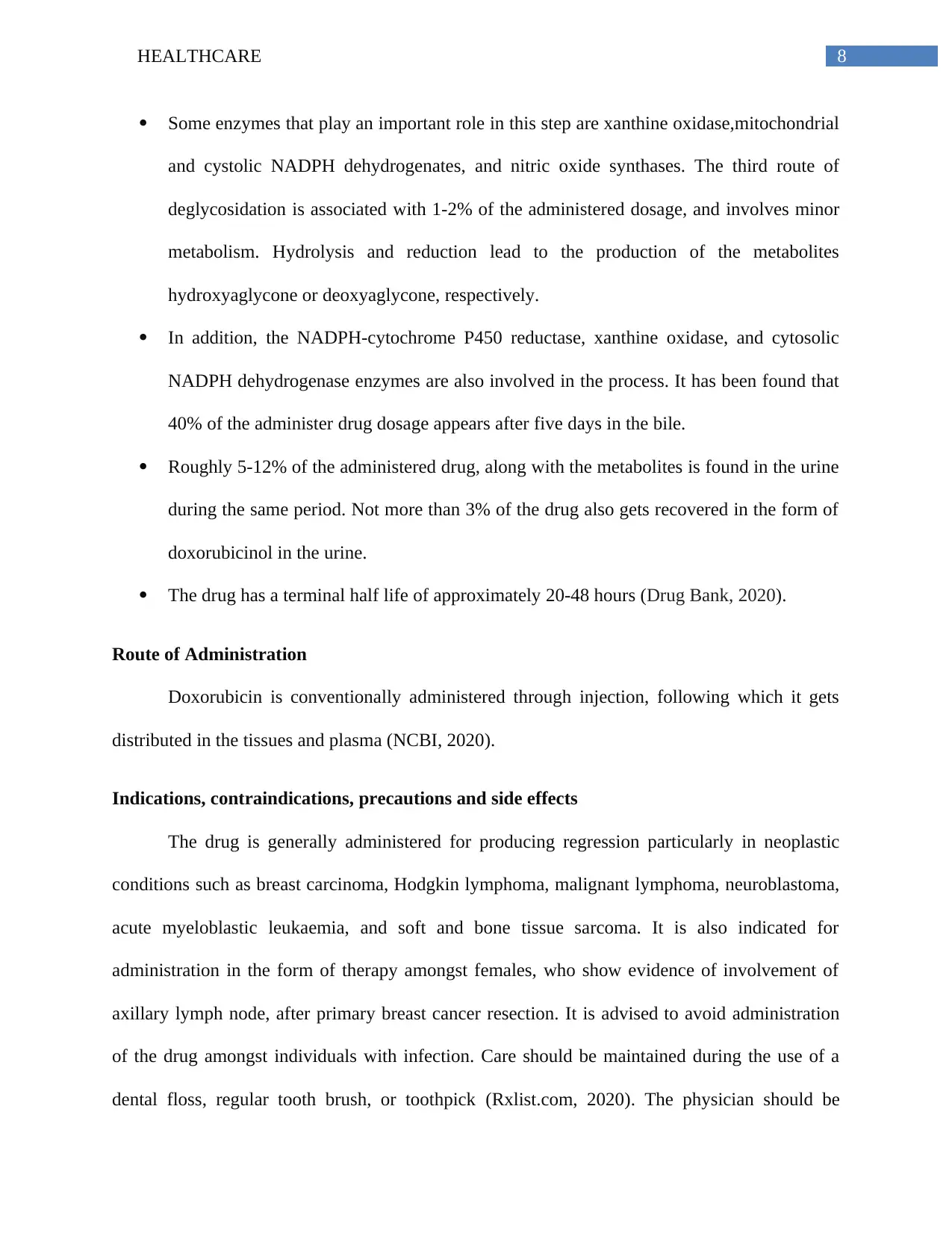
8HEALTHCARE
Some enzymes that play an important role in this step are xanthine oxidase,mitochondrial
and cystolic NADPH dehydrogenates, and nitric oxide synthases. The third route of
deglycosidation is associated with 1-2% of the administered dosage, and involves minor
metabolism. Hydrolysis and reduction lead to the production of the metabolites
hydroxyaglycone or deoxyaglycone, respectively.
In addition, the NADPH-cytochrome P450 reductase, xanthine oxidase, and cytosolic
NADPH dehydrogenase enzymes are also involved in the process. It has been found that
40% of the administer drug dosage appears after five days in the bile.
Roughly 5-12% of the administered drug, along with the metabolites is found in the urine
during the same period. Not more than 3% of the drug also gets recovered in the form of
doxorubicinol in the urine.
The drug has a terminal half life of approximately 20-48 hours (Drug Bank, 2020).
Route of Administration
Doxorubicin is conventionally administered through injection, following which it gets
distributed in the tissues and plasma (NCBI, 2020).
Indications, contraindications, precautions and side effects
The drug is generally administered for producing regression particularly in neoplastic
conditions such as breast carcinoma, Hodgkin lymphoma, malignant lymphoma, neuroblastoma,
acute myeloblastic leukaemia, and soft and bone tissue sarcoma. It is also indicated for
administration in the form of therapy amongst females, who show evidence of involvement of
axillary lymph node, after primary breast cancer resection. It is advised to avoid administration
of the drug amongst individuals with infection. Care should be maintained during the use of a
dental floss, regular tooth brush, or toothpick (Rxlist.com, 2020). The physician should be
Some enzymes that play an important role in this step are xanthine oxidase,mitochondrial
and cystolic NADPH dehydrogenates, and nitric oxide synthases. The third route of
deglycosidation is associated with 1-2% of the administered dosage, and involves minor
metabolism. Hydrolysis and reduction lead to the production of the metabolites
hydroxyaglycone or deoxyaglycone, respectively.
In addition, the NADPH-cytochrome P450 reductase, xanthine oxidase, and cytosolic
NADPH dehydrogenase enzymes are also involved in the process. It has been found that
40% of the administer drug dosage appears after five days in the bile.
Roughly 5-12% of the administered drug, along with the metabolites is found in the urine
during the same period. Not more than 3% of the drug also gets recovered in the form of
doxorubicinol in the urine.
The drug has a terminal half life of approximately 20-48 hours (Drug Bank, 2020).
Route of Administration
Doxorubicin is conventionally administered through injection, following which it gets
distributed in the tissues and plasma (NCBI, 2020).
Indications, contraindications, precautions and side effects
The drug is generally administered for producing regression particularly in neoplastic
conditions such as breast carcinoma, Hodgkin lymphoma, malignant lymphoma, neuroblastoma,
acute myeloblastic leukaemia, and soft and bone tissue sarcoma. It is also indicated for
administration in the form of therapy amongst females, who show evidence of involvement of
axillary lymph node, after primary breast cancer resection. It is advised to avoid administration
of the drug amongst individuals with infection. Care should be maintained during the use of a
dental floss, regular tooth brush, or toothpick (Rxlist.com, 2020). The physician should be
⊘ This is a preview!⊘
Do you want full access?
Subscribe today to unlock all pages.

Trusted by 1+ million students worldwide
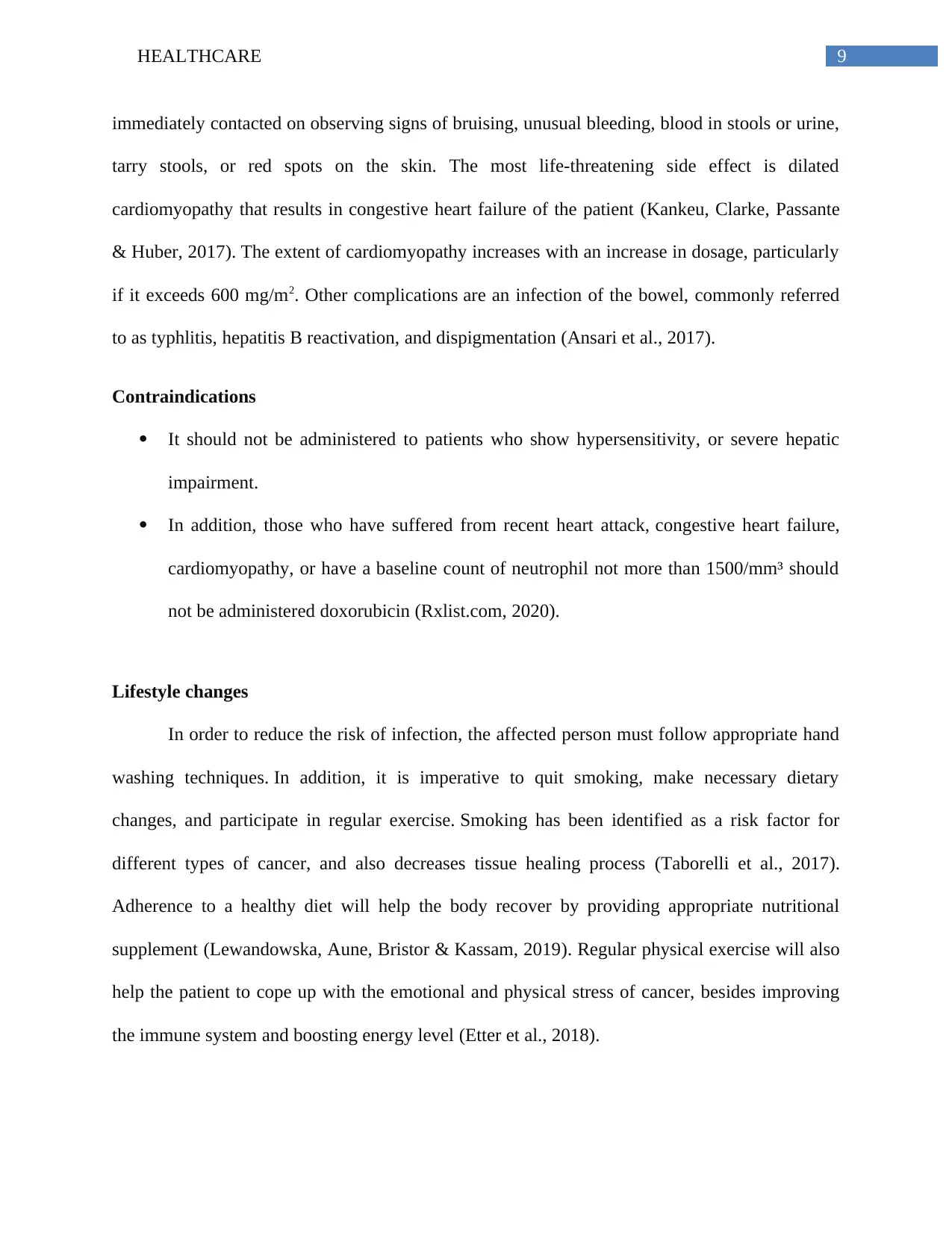
9HEALTHCARE
immediately contacted on observing signs of bruising, unusual bleeding, blood in stools or urine,
tarry stools, or red spots on the skin. The most life-threatening side effect is dilated
cardiomyopathy that results in congestive heart failure of the patient (Kankeu, Clarke, Passante
& Huber, 2017). The extent of cardiomyopathy increases with an increase in dosage, particularly
if it exceeds 600 mg/m2. Other complications are an infection of the bowel, commonly referred
to as typhlitis, hepatitis B reactivation, and dispigmentation (Ansari et al., 2017).
Contraindications
It should not be administered to patients who show hypersensitivity, or severe hepatic
impairment.
In addition, those who have suffered from recent heart attack, congestive heart failure,
cardiomyopathy, or have a baseline count of neutrophil not more than 1500/mm³ should
not be administered doxorubicin (Rxlist.com, 2020).
Lifestyle changes
In order to reduce the risk of infection, the affected person must follow appropriate hand
washing techniques. In addition, it is imperative to quit smoking, make necessary dietary
changes, and participate in regular exercise. Smoking has been identified as a risk factor for
different types of cancer, and also decreases tissue healing process (Taborelli et al., 2017).
Adherence to a healthy diet will help the body recover by providing appropriate nutritional
supplement (Lewandowska, Aune, Bristor & Kassam, 2019). Regular physical exercise will also
help the patient to cope up with the emotional and physical stress of cancer, besides improving
the immune system and boosting energy level (Etter et al., 2018).
immediately contacted on observing signs of bruising, unusual bleeding, blood in stools or urine,
tarry stools, or red spots on the skin. The most life-threatening side effect is dilated
cardiomyopathy that results in congestive heart failure of the patient (Kankeu, Clarke, Passante
& Huber, 2017). The extent of cardiomyopathy increases with an increase in dosage, particularly
if it exceeds 600 mg/m2. Other complications are an infection of the bowel, commonly referred
to as typhlitis, hepatitis B reactivation, and dispigmentation (Ansari et al., 2017).
Contraindications
It should not be administered to patients who show hypersensitivity, or severe hepatic
impairment.
In addition, those who have suffered from recent heart attack, congestive heart failure,
cardiomyopathy, or have a baseline count of neutrophil not more than 1500/mm³ should
not be administered doxorubicin (Rxlist.com, 2020).
Lifestyle changes
In order to reduce the risk of infection, the affected person must follow appropriate hand
washing techniques. In addition, it is imperative to quit smoking, make necessary dietary
changes, and participate in regular exercise. Smoking has been identified as a risk factor for
different types of cancer, and also decreases tissue healing process (Taborelli et al., 2017).
Adherence to a healthy diet will help the body recover by providing appropriate nutritional
supplement (Lewandowska, Aune, Bristor & Kassam, 2019). Regular physical exercise will also
help the patient to cope up with the emotional and physical stress of cancer, besides improving
the immune system and boosting energy level (Etter et al., 2018).
Paraphrase This Document
Need a fresh take? Get an instant paraphrase of this document with our AI Paraphraser
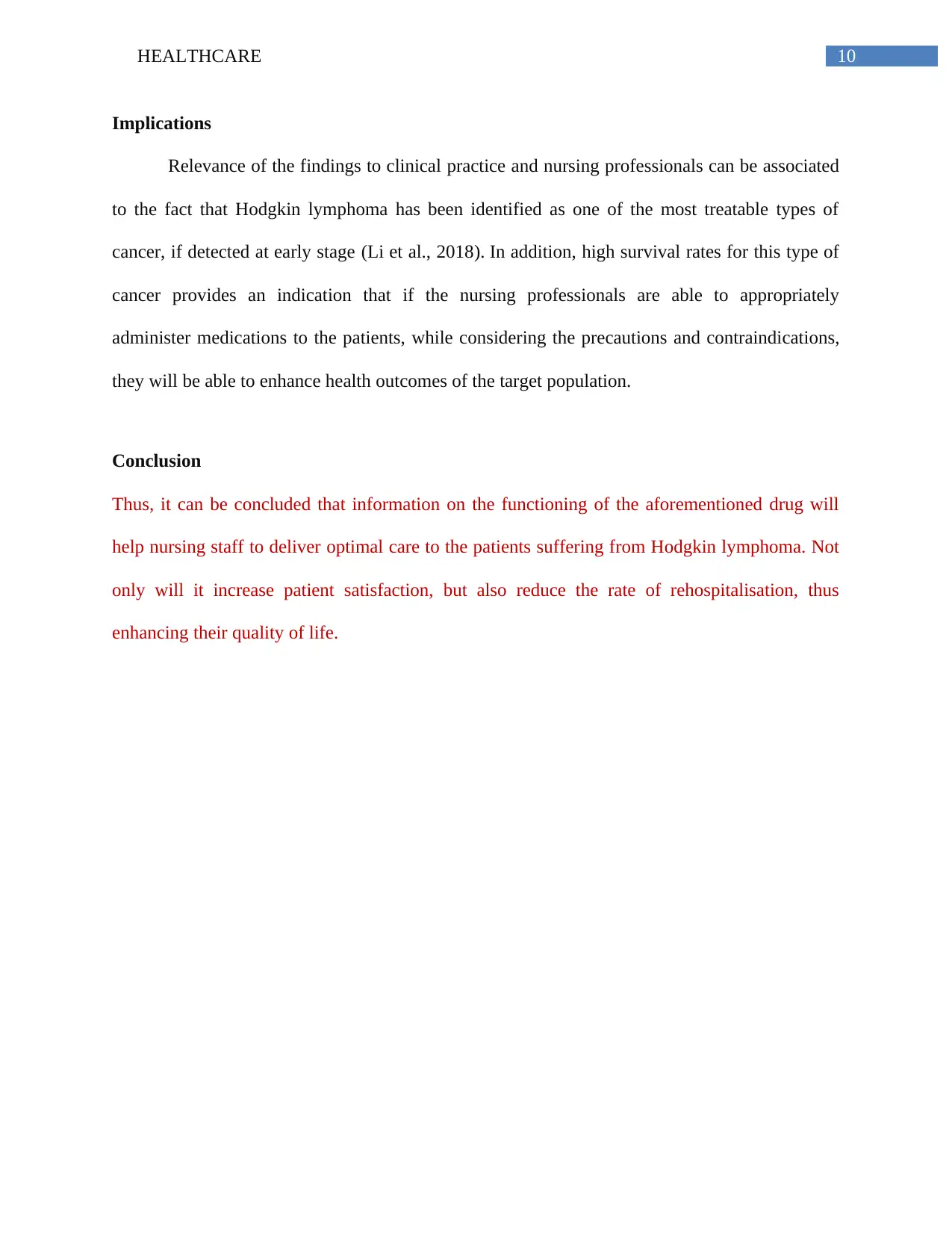
10HEALTHCARE
Implications
Relevance of the findings to clinical practice and nursing professionals can be associated
to the fact that Hodgkin lymphoma has been identified as one of the most treatable types of
cancer, if detected at early stage (Li et al., 2018). In addition, high survival rates for this type of
cancer provides an indication that if the nursing professionals are able to appropriately
administer medications to the patients, while considering the precautions and contraindications,
they will be able to enhance health outcomes of the target population.
Conclusion
Thus, it can be concluded that information on the functioning of the aforementioned drug will
help nursing staff to deliver optimal care to the patients suffering from Hodgkin lymphoma. Not
only will it increase patient satisfaction, but also reduce the rate of rehospitalisation, thus
enhancing their quality of life.
Implications
Relevance of the findings to clinical practice and nursing professionals can be associated
to the fact that Hodgkin lymphoma has been identified as one of the most treatable types of
cancer, if detected at early stage (Li et al., 2018). In addition, high survival rates for this type of
cancer provides an indication that if the nursing professionals are able to appropriately
administer medications to the patients, while considering the precautions and contraindications,
they will be able to enhance health outcomes of the target population.
Conclusion
Thus, it can be concluded that information on the functioning of the aforementioned drug will
help nursing staff to deliver optimal care to the patients suffering from Hodgkin lymphoma. Not
only will it increase patient satisfaction, but also reduce the rate of rehospitalisation, thus
enhancing their quality of life.
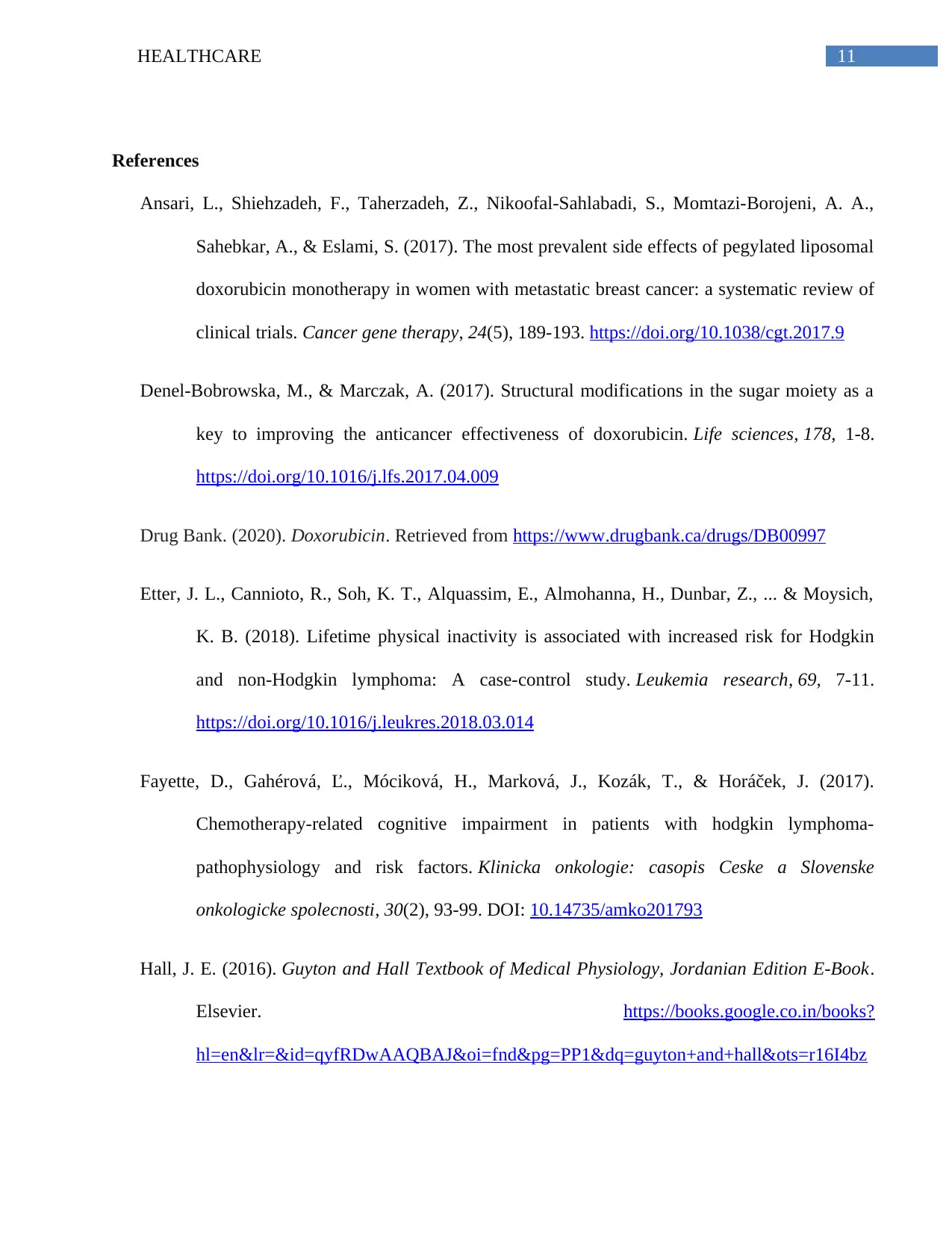
11HEALTHCARE
References
Ansari, L., Shiehzadeh, F., Taherzadeh, Z., Nikoofal-Sahlabadi, S., Momtazi-Borojeni, A. A.,
Sahebkar, A., & Eslami, S. (2017). The most prevalent side effects of pegylated liposomal
doxorubicin monotherapy in women with metastatic breast cancer: a systematic review of
clinical trials. Cancer gene therapy, 24(5), 189-193. https://doi.org/10.1038/cgt.2017.9
Denel-Bobrowska, M., & Marczak, A. (2017). Structural modifications in the sugar moiety as a
key to improving the anticancer effectiveness of doxorubicin. Life sciences, 178, 1-8.
https://doi.org/10.1016/j.lfs.2017.04.009
Drug Bank. (2020). Doxorubicin. Retrieved from https://www.drugbank.ca/drugs/DB00997
Etter, J. L., Cannioto, R., Soh, K. T., Alquassim, E., Almohanna, H., Dunbar, Z., ... & Moysich,
K. B. (2018). Lifetime physical inactivity is associated with increased risk for Hodgkin
and non-Hodgkin lymphoma: A case-control study. Leukemia research, 69, 7-11.
https://doi.org/10.1016/j.leukres.2018.03.014
Fayette, D., Gahérová, Ľ., Móciková, H., Marková, J., Kozák, T., & Horáček, J. (2017).
Chemotherapy-related cognitive impairment in patients with hodgkin lymphoma-
pathophysiology and risk factors. Klinicka onkologie: casopis Ceske a Slovenske
onkologicke spolecnosti, 30(2), 93-99. DOI: 10.14735/amko201793
Hall, J. E. (2016). Guyton and Hall Textbook of Medical Physiology, Jordanian Edition E-Book.
Elsevier. https://books.google.co.in/books?
hl=en&lr=&id=qyfRDwAAQBAJ&oi=fnd&pg=PP1&dq=guyton+and+hall&ots=r16I4bz
References
Ansari, L., Shiehzadeh, F., Taherzadeh, Z., Nikoofal-Sahlabadi, S., Momtazi-Borojeni, A. A.,
Sahebkar, A., & Eslami, S. (2017). The most prevalent side effects of pegylated liposomal
doxorubicin monotherapy in women with metastatic breast cancer: a systematic review of
clinical trials. Cancer gene therapy, 24(5), 189-193. https://doi.org/10.1038/cgt.2017.9
Denel-Bobrowska, M., & Marczak, A. (2017). Structural modifications in the sugar moiety as a
key to improving the anticancer effectiveness of doxorubicin. Life sciences, 178, 1-8.
https://doi.org/10.1016/j.lfs.2017.04.009
Drug Bank. (2020). Doxorubicin. Retrieved from https://www.drugbank.ca/drugs/DB00997
Etter, J. L., Cannioto, R., Soh, K. T., Alquassim, E., Almohanna, H., Dunbar, Z., ... & Moysich,
K. B. (2018). Lifetime physical inactivity is associated with increased risk for Hodgkin
and non-Hodgkin lymphoma: A case-control study. Leukemia research, 69, 7-11.
https://doi.org/10.1016/j.leukres.2018.03.014
Fayette, D., Gahérová, Ľ., Móciková, H., Marková, J., Kozák, T., & Horáček, J. (2017).
Chemotherapy-related cognitive impairment in patients with hodgkin lymphoma-
pathophysiology and risk factors. Klinicka onkologie: casopis Ceske a Slovenske
onkologicke spolecnosti, 30(2), 93-99. DOI: 10.14735/amko201793
Hall, J. E. (2016). Guyton and Hall Textbook of Medical Physiology, Jordanian Edition E-Book.
Elsevier. https://books.google.co.in/books?
hl=en&lr=&id=qyfRDwAAQBAJ&oi=fnd&pg=PP1&dq=guyton+and+hall&ots=r16I4bz
⊘ This is a preview!⊘
Do you want full access?
Subscribe today to unlock all pages.

Trusted by 1+ million students worldwide
1 out of 15
Your All-in-One AI-Powered Toolkit for Academic Success.
+13062052269
info@desklib.com
Available 24*7 on WhatsApp / Email
![[object Object]](/_next/static/media/star-bottom.7253800d.svg)
Unlock your academic potential
Copyright © 2020–2025 A2Z Services. All Rights Reserved. Developed and managed by ZUCOL.